module 60 Causes of Declining Biodiversity
We have seen that declines in biodiversity are happening around the globe. In “Science Applied 2: How Should We Prioritize the Protection of Species Diversity?” on page 184, we discussed biodiversity hotspots, which are areas around the world rich in biodiversity. Many organisms in these biodiversity hotspots face threats of extinctions due to human activities. However, threats to biodiversity exist throughout the world. In this module, we build on the basics of population and community ecology from Chapter 5 to understand how a number of factors can all affect biodiversity.
Learning Objectives
After reading this module you should be able to
discuss how habitat loss can lead to declines in species diversity.
explain how the movement of exotic species affects biodiversity.
describe how overharvesting causes declines in populations and species.
understand how pollution reduces populations and biodiversity.
identify how climate change affects species diversity.
Habitat loss is the major cause of declining species diversity
For most species, the greatest cause of decline and extinction is habitat loss. In modern times, the primary cause of habitat loss is human development that removes natural habitats and replaces them with homes, industries, agricultural fields, shopping malls, and roads. Many species can only thrive in a particular habitat within a narrow range of abiotic and biotic conditions. Species requiring such specialized habitats are particularly prone to population declines, especially when their favored habitat is limited, which restricts their distribution to a specific geographic area suitable only for a small population.
Altering distinctive characteristics of a habitat, such as removing trees or damming streams, has an effect on the organisms that live in that habitat. For example, for thousands of years the northern spotted owl (Strix occidentalis caurina) lived in old-

The map in FIGURE 60.2 shows the changing face of forest habitats over the past few decades. As we saw in Chapter 6, much of the forest in the United States during the 1700s and 1800s was logged for lumber and cleared for agriculture. In recent decades, forested land has been increasing, although humans have often planted the new forests, which have a lower diversity of species than the original forests. At the same time, developing countries in South America, sub-
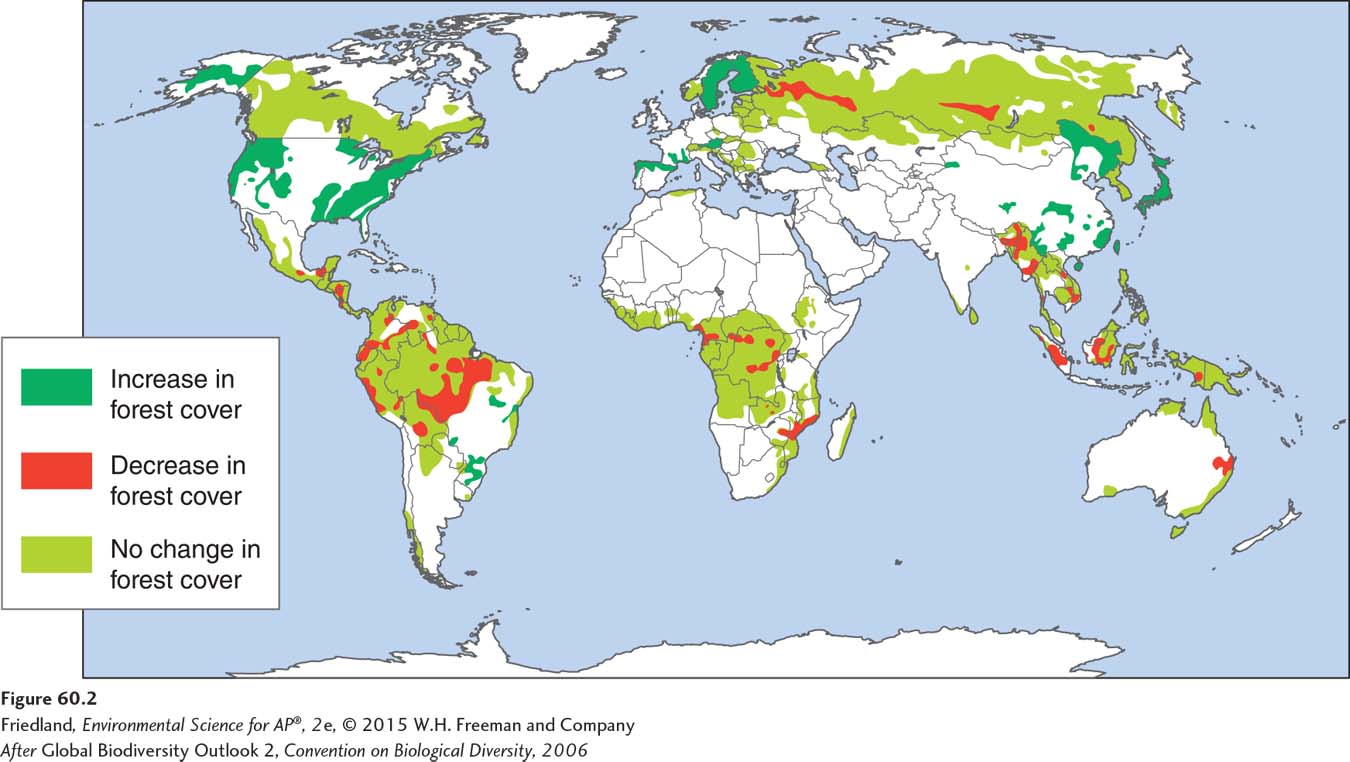
Although deforestation receives a lot of attention, many other habitats are also being lost. According to the Millennium Ecosystem Assessment, approximately 70 percent of the woodland/shrubland ecosystem that borders the Mediterranean Sea has been lost. Similarly, across the globe we have lost nearly 50 percent of grassland habitats and 30 percent of desert habitats. Wetlands exhibit a mixed picture. Although the amount of wetland habitat is less than half of what existed in the United States during the 1600s, from 1998 to 2004 the amount of freshwater wetland habitat actually increased. This overall growth occurred due to large increases in wetland habitat in the Great Lakes region. This growth offset a decline in coastal wetlands in the eastern United States and the Gulf of Mexico caused by growing human populations that built more roads, homes, and businesses.
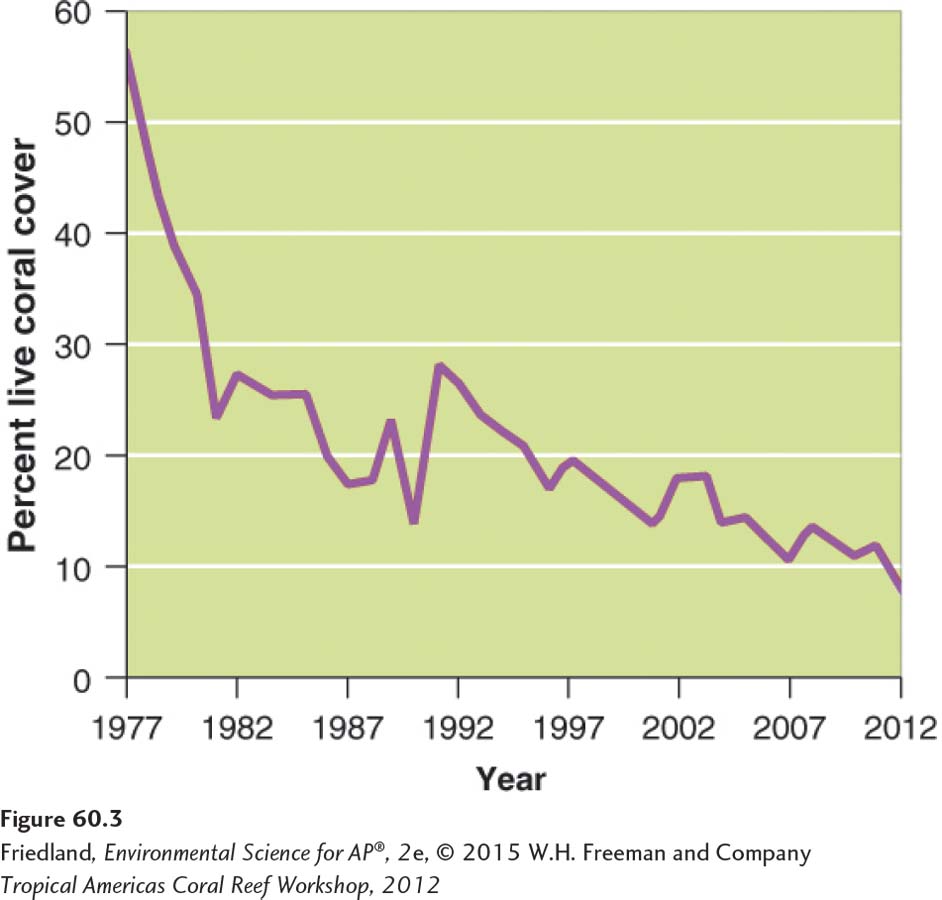
In marine systems, there has been a sharp decline in the amount of living coral in the Caribbean Sea, as shown in FIGURE 60.3, from a high of 50 percent live coral in the 1970s to a mere 8 percent by 2012. Living coral provide habitat for thousands of other species, which makes them particularly vital to the persistence of marine habitats. The decline in coral is the result of human impacts including the warming of oceans (associated with global warming), increased pollution, and the removal of coral by collectors. This loss of coral habitat is occurring at a rapid rate throughout the world.
A species may decline in abundance or become extinct even without complete habitat destruction since a reduction in the size of critical habitat also can lead to extinctions through a variety of processes. As we saw in the case of the Florida panther, a smaller habitat supports a smaller population, reducing genetic diversity. Less habitat also reduces the variety of physical and climatic options available to individuals during periods of extreme conditions. The presence of cooler, high-
Smaller habitats can also cause increased interactions with other harmful species. For example, many songbirds in North America live in forests. When these birds make their nests near the edge of the forests—
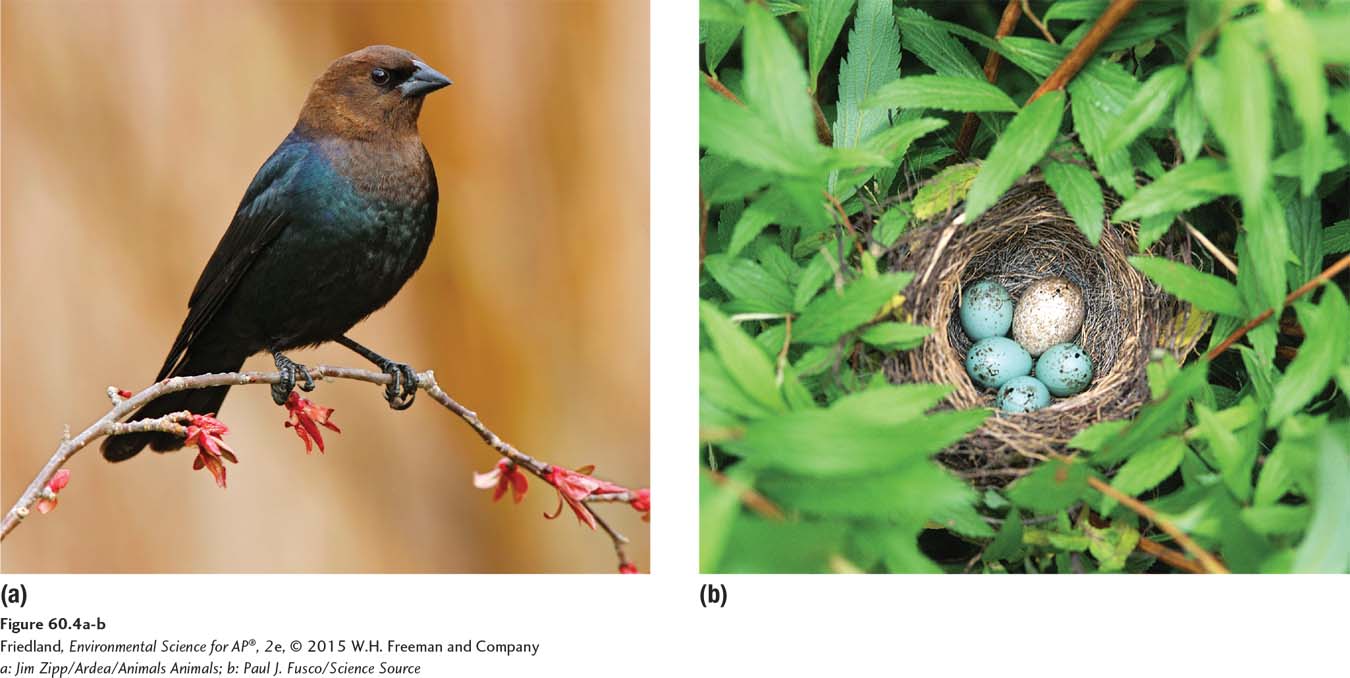
Exotic species are moving around the world
Native species Species that live in their historical range, typically where they have lived for thousands or millions of years.
Exotic species A species living outside its historical range. Also known as alien species.
Native species are species that live in their historical range, typically where they have lived for thousands or millions of years. In contrast, exotic species, also known as alien species, are species that live outside their historical range. For example, honeybees (Apis mellifera) were introduced to North America in the 1600s to provide a source of honey for European colonists. Red foxes (Vulpes vulpes), now abundant in Australia, were introduced there in the 1800s for the purpose of fox hunts, which were popular in Europe at the time.
During the past several centuries, humans have frequently moved animals, plants, and pathogens around the world. Some species are also moved accidentally. For example, rats that have stowed away in shipping containers have ended up on distant oceanic islands. Because these islands never had rats or other ground predators, there had never been any natural selection against nesting on the ground, and numerous island bird species had evolved to nest on the ground. When the rats arrived, they found the eggs and hatchlings from ground nests an easy source of food, resulting in a high rate of extinction in ground-
Invasive species A species that spreads rapidly across large areas.
In most cases, exotic species fail to establish successful populations when they are introduced to a new region. For the small percentage of introductions that are successful, exotic species can live in their new surroundings and have no negative effect on the native species. In other cases, however, the exotic species rapidly increase in population size and cause harmful effects on native species. When exotic species spread rapidly across large areas, we call them invasive species. Rapid spread of invasive species is possible because invasive species, which have natural enemies in their native regions that act to control their population, often have no natural enemies in the regions where they are introduced. Two of the best-
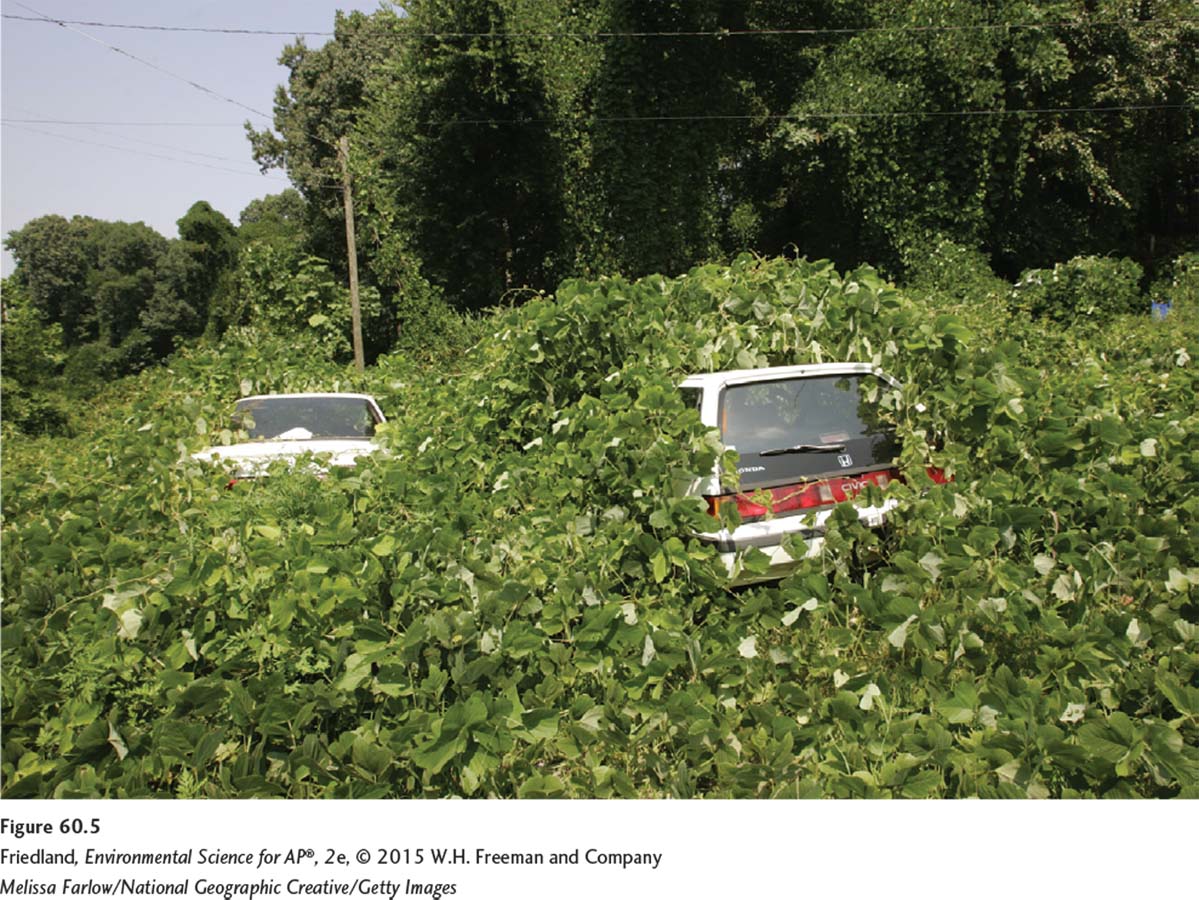
The kudzu vine is native to Japan and southeast China but was introduced to the United States in 1876. Throughout the early 1900s, farmers in the southeastern states were encouraged to plant kudzu to help reduce erosion in their fields. By the 1950s, it became apparent that the southeastern climate was ideal for kudzu, with growth rates of the vine approaching 0.3 m (1 foot) per day. Because herbivores in the region do not eat kudzu, the species has no enemies and can spread rapidly. The vine grows up over most wildflowers and trees and shades them from the sunlight, causing the plants to die. Indeed, the vine grows over just about anything that does not move (FIGURE 60.5). Kudzu currently covers approximately 2.5 million hectares (7 million acres) in the United States.
The zebra mussel is native to the Black Sea and the Caspian Sea in eastern Europe and western Asia. Over the years, large cargo ships that traveled in these seas unloaded their cargo in the ports of the Black Sea and Caspian Sea and then pumped seawater into the holding tanks to ensure that the ship sat low enough in the water to remain stable. This water that is pumped into the ship is called ballast water. When the ships arrived in the St. Lawrence River and the Great Lakes, they loaded on new cargo and no longer needed the weight of the ballast water, which they pumped out of the ship into local waters. One consequence of transporting ballast water from Asia to North America is that many aquatic species from Asia, including zebra mussels, have been introduced into the aquatic ecosystems of North America. Because the St. Lawrence River and the Great Lakes provided an ideal ecosystem for the zebra mussel, and because a single zebra mussel can produce up to 30,000 eggs, the mussel spread rapidly through the Great Lakes ecosystem. On the positive side, because the mussels feed by filtering the water, they remove large amounts of algae and some contaminants, which, to some degree, counteracts the cultural eutrophication that has occurred in the Great Lakes ecosystem. On the negative side, the zebra mussels physically crowd out many native mussel species and the zebra mussels can consume so much algae that they negatively affect native species that also need to consume the algae. Moreover, the invasive mussels can achieve such high densities that they can clog intake pipes and impede the flow of water on which industries and communities rely.

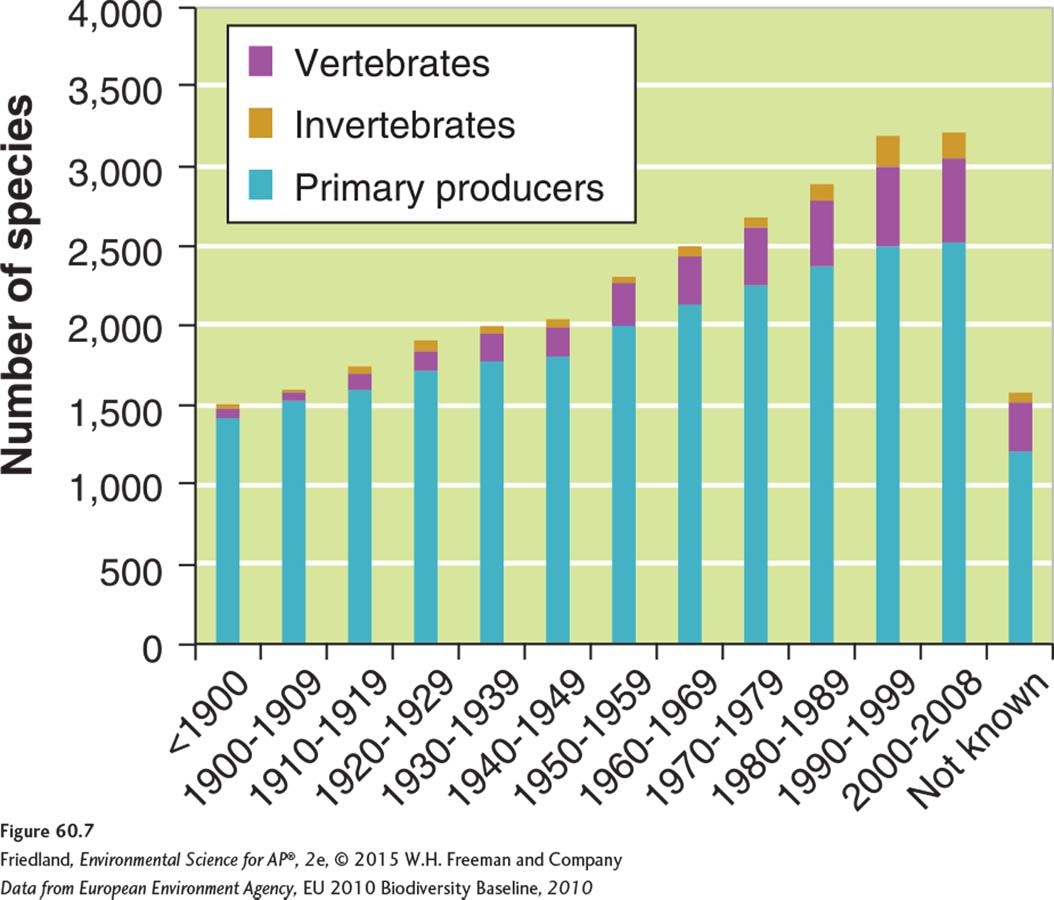
A new threat to the Great Lakes is the silver carp (Hypophthalmichthys molitrix), a fish that is native to Asia but has been transported around the world in an effort to consume excess algae that accumulates in aquaculture operations and the holding ponds of sewage treatment plants. After being brought to the United States, some of the fish escaped and rapidly spread through many of the major river systems, including the Mississippi River. Over the years, the carp population has expanded northward, and by 2010 it approached a canal where the Mississippi River connects to Lake Michigan. Although researchers detected the DNA of the carp in water samples from the Great Lakes from 2009 to 2011, substantial netting efforts in the spring of 2013 failed to find any of the fish in the lakes. There are two major concerns about this invading fish. First, scientists worry that it will outcompete native species of fish that also consume algae. Second, the silver carp has an unusual behavior; it jumps out of the water when startled by passing boats (FIGURE 60.6). Given that the carp can grow to 18 kg (40 pounds) and jump up to 3 m (10 feet) into the air, this poses a major safety issue to boaters.
Around the world, invasive exotic species pose a serious threat to biodiversity by acting as predators, pathogens, or superior competitors to native species. Some of the most complete data exist in Europe. As FIGURE 60.7 shows, during the past 100 years, Europe has experienced a steady increase of nearly 2,000 exotic species in terrestrial ecosystems. Additional species have been introduced into freshwater and marine ecosystems. A number of efforts are currently being used to reduce the introduction of invasive exotic species, including the inspection of goods coming into a country and the prohibition of wooden packing crates made of untreated wood that could contain insect pests.
Overharvesting causes declines in populations and species
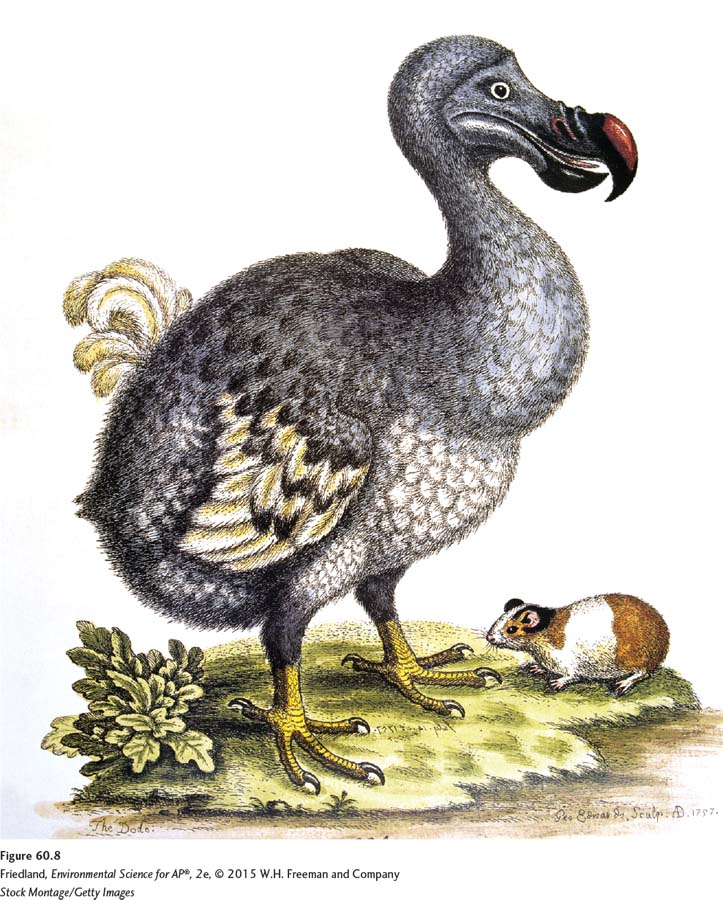
Hunting, fishing, and other forms of harvesting are the most direct human influences on wild populations of plants and animals. Most species can be harvested to some degree, but a species is overharvested when individuals are removed at a rate faster than the population can replace them. In the extreme, overharvesting of a species can cause extinction. In the seventeenth century, for example, ships sailing from Europe stopped for food and water at Mauritius, an uninhabited island in the Indian Ocean. On Mauritius, the sailors would hunt the dodo (Raphus cucullatus), a large flightless bird that had no innate fear of humans because it had never seen humans during its evolutionary history (FIGURE 60.8). The dodo, unable to protect itself from human hunters and the rats (introduced by humans) that consumed dodo eggs and hatchlings, became extinct in just 80 years. This same scenario appears to have taken place with many other large animal species as well. These animals include the giant ground sloths, mammoths, American camels of North and South America, and the 3.7 m (12 feet) tall moa birds of New Zealand. Each species became extinct soon after humans arrived, suggesting that the animals’ demise may have been due to overharvesting.
Overharvesting has also occurred in the more recent past. In the 1800s and early 1900s, for example, market hunters slaughtered wild animals to sell their parts on such a scale that many species, including the American bison, declined dramatically. Bison were once abundant on the western plains, with estimates ranging from 60 to 75 million individuals. By the late 1800s fewer than 1,000 were left. This means that 99.999 percent of all bison were killed. Following enactment of legal protections, the bison population today has increased to more than 500,000, including both wild bison and bison raised commercially for meat.
Not all species harvested by market hunters fared as well as the American bison. The passenger pigeon was once one of the most abundant species of birds in North America. Population estimates range from 3 to 5 billion birds in the nineteenth century. In fact, during annual migrations, people observed continuous flocks of pigeons flying overhead for 3 days straight in densities that blocked out most of the sun. Breeding flocks could cover 40,000 ha (100,000 acres) with 100 nests built into each tree. With such high densities, market hunters could shoot or net the birds in very large numbers and fill train cars with harvested pigeons to be sold in eastern cities. This overharvesting, combined with the effects of forest clearing for agriculture, caused the passenger pigeon to decline quickly. The last passenger pigeon died in 1914 at the Cincinnati Zoo.
During the past century, regulations have been passed to prevent the overharvesting of plants and animals. In the United States, for example, state and federal regulations restrict hunting and fishing of game animals to particular times of the year and limit the number of animals that can be harvested. Similar agreements have been reached among countries through international treaties. In general, these regulations have proven very successful in preventing species declines caused by overharvesting. In some regions of the world, however, harvest regulations are not enforced and illegal poaching, especially of large, rare animals that include tigers, rhinoceroses, and apes, continues to threaten species with extinction. Harvesting of rare plants, birds, and coral reef dwellers for private collections has also jeopardized these species.
Plant and Animal Trade
Lacey Act A U.S. act that prohibits interstate shipping of all illegally harvested plants and animals.
For some species, the legal and illegal trade in plants and animals represents a serious threat to their ability to persist in nature. One of the earliest laws in the United States to control the trade of wildlife was the Lacey Act. First passed in 1900, the act originally prohibited the transport of illegally harvested game animals, primarily birds and mammals, across state lines. Over the years, a number of amendments have been added so that the Lacey Act today forbids the interstate shipping of all illegally harvested plants and animals.
Convention on International Trade in Endangered Species of Wild Fauna and Flora (CITES) A 1973 treaty formed to control the international trade of threatened plants and animals.
Red List A list of worldwide threatened species.
At the international level, the United Nations Convention on International Trade in Endangered Species of Wild Fauna and Flora, also known as CITES, was developed in 1973 to control the international trade of threatened plants and animals. Today, CITES is an international agreement among 175 countries throughout the world. The IUCN maintains a list of threatened species known as the Red List. Each member country assigns a specific agency to monitor and regulate the import and export of animals on the list. For example, in the United States, the U.S. Fish and Wildlife Service conducts this oversight.

Despite such international agreements, much illegal plant and animal trade still occurs throughout the world. In 2008, a report by the Congressional Research Service estimated that illegal trade in wildlife was worth $5 billion to $20 billion annually. In some cases, animals are sold for fur or for body parts that are thought to have medicinal value. In other cases, rare animals are in demand as pets. For example, in 2001 a population of the Philippine forest turtle (Siebenrockiella leytensis), once thought to be extinct, was discovered on a single island in the Philippines (FIGURE 60.9). This animal, one of the most endangered species in the world, cannot be traded legally, but demand for it as a pet has caused it to be sold illegally and the last remaining population has declined sharply in only a few years. A single turtle sells for $50 to $75 in the Philippines and up to $2,500 in the United States and Europe. Similar cases of illegal trade occur in rare species of trees for lumber such as big-
Sometimes even when trade in a particular species is legal, it can pose a potential long-
Pollution can have harmful effects on species
In Chapters 14 and 15, we saw how water and air pollution harm ecosystems. Threats to biodiversity come from toxic contaminants such as pesticides, heavy metals, acids, and oil spills. Other contaminants, such as endocrine disrupters, can have nonlethal effects that prevent or inhibit reproduction. Pollution sources that cause declines in biodiversity also include the release of nutrients that cause algal blooms and dead zones as well as thermal pollution that can make water bodies too warm for species to survive.
In 2010, for example, an oil platform in the Gulf of Mexico owned by BP and named the Deepwater Horizon exploded, causing a massive release of oil that lasted for several months. As we discussed in Chapter 14, the release of oil caused a tremendous amount of death across a wide range of animal species including sea turtles, pelicans, fish, and shellfish. In response to the massive oil spill, BP released hundreds of thousands of liters of oil dispersant, a chemical designed to break up large areas of oil into tiny droplets that can be consumed by specialized species of bacteria. However, the dispersant is also toxic to many species of animals. The total impact of the spilled oil and applied dispersants on the wildlife of the Gulf of Mexico may not be known for many years.
Climate change has the potential to affect species diversity
We have mentioned climate change in previous chapters and will discuss it in detail in Chapter 19. As a threat to biodiversity, the primary concern about climate change is its effect on patterns of temperature and precipitation in different regions of the world. In some regions, a species may be able to respond to warming temperatures and changes in precipitation by migrating to a place where the climate is well suited to the species niche. In other cases, this is not possible. For example, in southwestern Australia, a small woodland/shrubland peninsula exists on the edge of the continent with a much larger area of subtropical desert farther inland (see FIGURE 12.3 on page 123). Scientists expect conditions on the peninsula to become drier during the next 70 years. If this occurs, many species of plants in this small ecosystem will not have a nearby hospitable environment to which they can migrate, since the surrounding desert ecosystem is already too dry for them. An examination of 100 species of plants in the area (all from the genus Banksia) has led scientists to project that 66 percent of the species will decline in abundance and up to 25 percent will become extinct. As we will see in Chapter 19, many species in the world are expected to be affected by climate change.